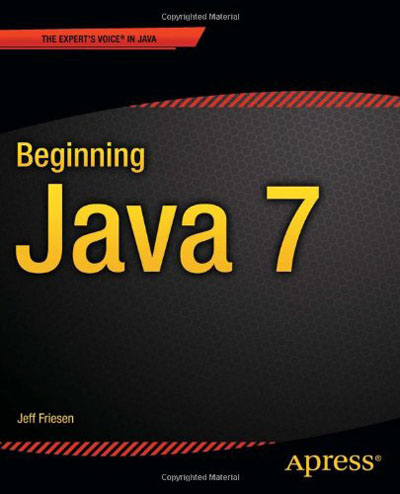Publisher: Apr..ess 2011 | 920 Pages | ISBN: 1430239093 | EPUB + PDF | 14 MB + 11 MB
Beginning Java 7 guides you through this language and a huge assortment of platform APIs according to the following table of contents:
Chapter 1: Getting Started with Java
Chapter 2: Discovering Classes and Objects
Chapter 3: Exploring Advanced Language Features
Chapter 4: Touring Language APIs
Chapter 5: Collecting Objects
Chapter 6: Touring Additional Utility APIs
Chapter 7: Creating and Enriching Graphical User Interfaces
Chapter 8: Interacting with Filesystems
Chapter 9: Interacting with Networks and Databases
Chapter 10: Parsing, Creating, and Transforming XML Documents
Chapter 11: Working with Web Services
Chapter 12: Java 7 Meets Android
Appendix A: Solutions to Exercises
Appendix B: Scripting API and Dynamically Typed Language Support
Appendix C: Odds and Ends
Appendix D: Applications Gallery
Chapter 1 introduces you to Java and begins to cover the Java language by focusing on fundamental concepts such as comments, identifiers, variables, expressions, and statements.
Chapter 2 continues to explore this language by presenting all of its features for working with classes and objects. You learn about features related to class declaration and object creation, encapsulation, information hiding, inheritance, polymorphism, interfaces, and garbage collection.
Chapter 3 focuses on the more advanced language features related to nested classes, packages, static imports, exceptions, assertions, annotations, generics, and enums. Additional chapters will introduce you to the few features not covered in Chapters 1 through 3.
Chapter 4 largely moves away from covering language features (although it does introduce class literals and strictfp) while focusing on language-oriented APIs. You learn about Math, StrictMath, Package, Primitive Type Wrapper Classes, Reference, Reflection, String, StringBuffer and StringBuilder, Threading, BigDecimal, and BigInteger in this chapter.
Chapter 5 begins to explore Java's utility APIs by focusing largely on the Collections Framework. However, it also discusses legacy collection-oriented APIs and how to create your own collections.
Chapter 6 continues to focus on utility APIs by presenting the concurrency utilities along with the Objects and Random classes.
Chapter 7 moves you away from the command-line user interfaces that appear in previous chapters and toward graphical user interfaces. You first learn about the Abstract Window Toolkit foundation, and then explore the Java Foundation Classes in terms of Swing and Java 2D. Appendix C explores Accessibility and Drag and Drop.
Chapter 8 explores filesystem-oriented I/O in terms of the File, RandomAccessFile, stream, and writer/reader classes. New I/O is covered in Appendix C.
Chapter 9 introduces you to Java's network APIs, such as sockets. It also introduces you to the JDBC API for interacting with databases.
Chapter 10 dives into Java's XML support by first presenting an introduction to XML (including DTDs and schemas). It next explores the SAX, DOM, StAX, XPath, and XSLT APIs. It even briefly touches on the Validation API. While exploring XPath, you encounter namespace contexts, extension functions and function resolvers, and variables and variable resolvers.
Chapter 11 introduces you to Java's support for SOAP-based and RESTful web services. In addition to providing you with the basics of these web service categories, Chapter 11 presents some advanced topics, such as working with the SAAJ API to communicate with a SOAP-based web service without having to rely on JAX-WS. You will appreciate having learned about XML in Chapter 10 before diving into this chapter.
Chapter 12 helps you put to use some of the knowledge you've gathered in previous chapters by showing you how to use Java to write an Android app's source code. This chapter introduces you to Android, discusses its architecture, shows you how to install necessary tools, and develops a simple app.
What you’ll learn
The entire Java language, including Java 7-specific features such as switch on string, try-with-resources, final rethrow, multicatch, and SafeVarargs
A huge assortment of Java 7 APIs, beginning with those APIs oriented toward the language itself, and including Java 7-specific APIs such as the Fork/Join Framework, Objects, JLayer, and NIO.2
Various Java 7 tools, starting with the javac compiler and java application launcher
How to create user interfaces, working with web services, and a whole lot more
The basics of getting started with Android app development
Who this book is for
This book targets the following groups of developers:
Newcomers, skilled (to some degree) in other programming languages but with no previous exposure to Java
Intermediate Java developers, skilled in the fundamentals of Java prior to Java 7 and looking to increase their understanding of Java 7 language/API changes
All developers looking beyond standard Java, who want to leverage Java 7 to create mobile apps via Android
Even advanced Java developers may find a few items of interest



